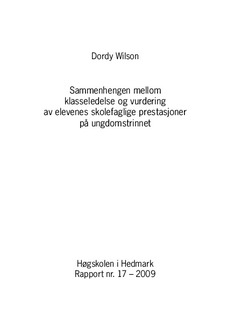| dc.contributor.author | Wilson, Dordy | |
| dc.date.accessioned | 2010-01-25T08:51:49Z | |
| dc.date.issued | 2010 | |
| dc.identifier.isbn | 978-82-7671-767-9 | |
| dc.identifier.issn | 1501-8563 | |
| dc.identifier.uri | http://hdl.handle.net/11250/133764 | |
| dc.description.abstract | Norsk: Norske skoleelevers svake faglige prestasjoner, avdekket
gjennom PISA undersøkelsen (Kjærnsli 2007), er i senere tid
blitt gjenstand for debatter omkring skolens innhold. St.meld. nr. 30
(2003–2004), nr. 16 (2006–2007), og nr. 30 (2007–2008), samt nr. 11
(2008–2009) ser lærerens kompetanse som viktig for å øke elevenes
læringseffekt. Våren 2009 ble det ved Høgskolen i Hedmark gjennomført
en studie for å finne sammenhengen mellom klasselede og elevenes
vurderingsresultater, der klasseledelse betraktes som kommunikasjonsformer
ut fra systemteoretisk perspektiv.
Hensikten er å finne
frem til kommunikasjonsformer som gir grunnlag for økt læringseffekt,
samt kommunikasjonsformer som utgjør en fare for lavt læringsutbytte.
Studiet er basert på kvantitative og kvalitative analyser. Gjennom statistiske
analyser av en kartleggingsundersøkelse høsten 2008 er det valgt ut 4
ungdomsskoler, der utvalget er basert på maksimal variasjon av elevenes
opplevelse av læringsmiljøet. I de 4 utvalgte skolene er det observert 59
undervisningsøkter ved hjelp av strukturert observasjon og mer åpne notater
av kommunikasjonsformen, samt gjennomført intervjuer. Totalt har
det deltatt 26 lærere og 4 skoleledere. En vurdering av sammenhengen
i det kvalitative og kvantitative materialet gir grunnlag for å dokumentere
sammenhengen mellom klasseledelse og elevenes vurderingsresultater.
Resultatene viser at klasseledelsens kommunikasjonsform er sterkt knyttet
til læreren, siden det er store variasjoner mellom grupper på samme skole.
Dette innebærer at sosioøkonomiske bakgrunnsvariabler har mindre betydning
for elevenes vurderingsresultater. Derimot kan læringseffekten øke, og
variasjonene mellom grupper i samme skole reduseres når skoleledelsen tydelig
kommuniserer skolens verdier og forventninger til lærerrollen. Funn fra
undersøkelsen viser at der læreren har et faglig og sosialt engasjement er
det i større grad tillitskapende kommunikasjon mellom deltakerne i gruppen, og lærerens engasjement påvirker undervisningsformens struktur. Læreren
utøver i større grad kontroll over læringsarbeidet ved å følge
opp elevenes forståelse, i tillegg til at de støtter og oppmuntrer elevene
i læringsarbeidet. I undervisningsøkter med bruk av dialog og
verbalisering
av kunnskaper, responderer
både jenter og gutter likt ved
å tilkoble seg til læring. Klasseledelse med denne typen kommunikasjonsform
viser sterk sammenheng med gode faglige vurderingsresultater
hos elevene, og kan slik sies å gi et grunnlag for økt læringsutbytte. | en |
| dc.description.abstract | The weak performance by Norwegian pupil’s, which were uncovered
in the PISA study (Kjærnsli 2007), have been the focus of the debate
on the content of the present Norwegian education system. The St.meld 30
(2003–2004), 16 (2006–2007), 30 (2007–2008) and 11 (2008–2009) all
focus on the importance of the teacher’s competence as the major factor
in improving the overall performance of the pupils. In the spring of 2009
The University College of Hedmark did a study to find the connection between
classroom management and the pupils’ results. The study perceives
classroom management as categorized types of communications set in
a system theoretical perspective. The purpose is to identify the specific
forms of communication that creates the basis for better performance and
the forms of communication that create the basis for poorer performance.
The study is based on both quantitative and qualitative analysis. Through
Statistical analysis of a previous mapping in the autumn of 2008 4 secondary
schools where chosen. The selection was made to maximize the variation
of the pupils’ perception of the environment for learning. In the 4
schools there where made observations of 59 class lessons by structured
observations, open notes on forms of communication and interviews. A
total of 26 teachers and 4 principals have participated. The evaluation of
the coherence in the quantitative and qualitative material results in a clear
connection between classroom management and the results of the pupils.
The results clearly indicate that the classroom management’s form of communication
is strongly associated with the teacher, since the results also
show major variations between groups at the same school. The study also
seems to imply that socio economic factors are less important for the results
of the pupils. It clearly indicates that the effect of learning can improve
and the variations between groups within the same school can decrease
when the schools management clearly communicates the schools values and expectations to their teachers. Findings in the study also shows that in the
classes where the teacher are more dedicated both socially and in the subject
itself, there are more confidence in the communication between the
members of the group and the dedication of the teacher influences the structure
of the learning process. These teachers have a tendency to exercise
control of learning process by following up on the pupils understanding of
the subject in addition to supporting and encouraging the pupils in their
work. In the lessons with a lot of dialog and verbalization of knowledge both
girls and boys respond at the same level by attaching to learning. Classroom
management with this form of communication shows a strong coherence
with improved results for the pupils and thus gives increased learning. | |
| dc.format.extent | 1267045 bytes | |
| dc.format.mimetype | application/pdf | |
| dc.language.iso | nob | en |
| dc.relation.ispartofseries | Høgskolen i Hedmark - Rapport | en |
| dc.relation.ispartofseries | 17 - 2009 | en |
| dc.subject | klasseledelse | en |
| dc.title | Sammenhengen mellom klasseledelse og vurdering av elevenes skolefaglige prestasjoner på ungdomstrinnet | en |
| dc.title.alternative | The relationship between classroom management and assessment of pupils’ school academic achievement in secondary schools | en |
| dc.type | Research report | en |
| dc.subject.nsi | VDP::Social science: 200::Education: 280 | en |
